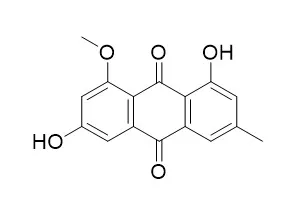| Description: |
Questin has promising inhibitory potential against AChE, BChE, and BACE1, it may be used in the development of therapeutic or preventive agents for Alzheimer's disease. Questin is a Cdc25B phosphatase inhibitor, it inhibited the enzymatic activity of Cdc25B phosphatase with the IC(50) value of 34 microg/mL, it also strongly inhibited the growth of human colon cancer cells, SW620 with the GI(50) value of 0.9 microg/mL. Questin shows considerably high immunosuppressive activity. |
| In vitro: |
| PLoS One. 2012;7(2):e29906. | | Trypacidin, a spore-borne toxin from Aspergillus fumigatus, is cytotoxic to lung cells.[Pubmed: 22319557 ] | Inhalation of Aspergillus fumigatus conidia can cause severe aspergillosis in immunosuppressed people. A. fumigatus produces a large number of secondary metabolites, some of which are airborne by conidia and whose toxicity to the respiratory tract has not been investigated. We found that spores of A. fumigatus contain five main compounds, tryptoquivaline F, fumiquinazoline C, Questin, monomethylsulochrin and trypacidin.
METHODS AND RESULTS:
Fractionation of culture extracts using RP-HPLC and LC-MS showed that samples containing Questin, monomethylsulochrin and trypacidin were toxic to the human A549 lung cell line. These compounds were purified and their structure verified using NMR in order to compare their toxicity against A549 cells.
CONCLUSIONS:
Trypacidin was the most toxic, decreasing cell viability and triggering cell lysis, both effects occurring at an IC₅₀ close to 7 μM. Trypacidin toxicity was also observed in the same concentration range on human bronchial epithelial cells.
In the first hour of exposure, trypacidin initiates the intracellular formation of nitric oxide (NO) and hydrogen peroxide (H₂O₂).
This oxidative stress triggers necrotic cell death in the following 24 h. The apoptosis pathway, moreover, was not involved in the cell death process as trypacidin did not induce apoptotic bodies or a decrease in mitochondrial membrane potential. This is the first time that the toxicity of trypacidin to lung cells has been reported. | | Nat Prod Res. 2007 May 20;21(6):487-93. | | Anthraquinones, Cdc25B phosphatase inhibitors, isolated from the roots of Polygonum multiflorum Thunb.[Pubmed: 17497420] |
METHODS AND RESULTS:
Three anthraquinones, Cdc25B phosphatase inhibitors, were isolated from the methanolic extract of the roots of Polygonum multiflorum Thunb. (Polygonaceae).
CONCLUSIONS:
Anthraquinones, physcion (1), emodin (2), and Questin (3), inhibited the enzymatic activity of Cdc25B phosphatase with IC(50) values of 62.5, 30, and 34 microg mL(-1), respectively. Emodin (2) and Questin (3) strongly inhibited the growth of human colon cancer cells, SW620 with GI(50) values of 6.1 and 0.9 microg mL(-1), respectively.
Commercially available anthraquinones, chrysophanol (4), and rhein (5) also inhibited Cdc25B phosphatase with IC(50) values of 10.7 and 22.1 microg mL(-1), respectively. | | Chem Pharm Bull (Tokyo). 1999 Oct;47(10):1426-32. | | Immunomodulatory constituents from an ascomycete, Microascus tardifaciens.[Pubmed: 10553639] |
METHODS AND RESULTS:
Fractionation guided by the immunosuppressive activity of the defatted AcOEt extract of an Ascomycete, Microascus tardifaciens, afforded eight constituents, Questin (emodin 8-O-methylether) (1), rubrocristin (2), 5,7-dihydroxy-4-methylphthalide (3), cladosporin (asperentin) (4), cladosporin 8-O-methylether (5), tradioxopiperazine A [cyclo-L-alanyl-5-isopentenyl-2-(1',1'-dimethylallyl)-L-tryptophan] (6), tradioxopiperazine B [cyclo-L-alanyl-7-isopentenyl-2-(1',1'-dimethylallyl)-L-tryptophan] (7), and asperflavin (8), among which 6 and 7 were new compounds.
CONCLUSIONS:
Compounds 1 and 2 showed considerably high immunosuppressive activity, 6 was moderate and, 3, 4, 5, 7 and 8 showed low activity. |
|






 Cell. 2018 Jan 11;172(1-2):249-261.e12. doi: 10.1016/j.cell.2017.12.019.IF=36.216(2019)
Cell. 2018 Jan 11;172(1-2):249-261.e12. doi: 10.1016/j.cell.2017.12.019.IF=36.216(2019) Cell Metab. 2020 Mar 3;31(3):534-548.e5. doi: 10.1016/j.cmet.2020.01.002.IF=22.415(2019)
Cell Metab. 2020 Mar 3;31(3):534-548.e5. doi: 10.1016/j.cmet.2020.01.002.IF=22.415(2019) Mol Cell. 2017 Nov 16;68(4):673-685.e6. doi: 10.1016/j.molcel.2017.10.022.IF=14.548(2019)
Mol Cell. 2017 Nov 16;68(4):673-685.e6. doi: 10.1016/j.molcel.2017.10.022.IF=14.548(2019)